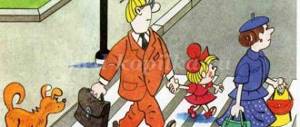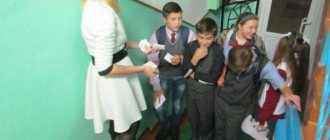Features of Cossack games
The main advantages of Cossack games are conciseness, expressiveness and accessibility. They help broaden one’s horizons, improve mental processes, and also stimulate active thought. Cossack games do not require special sports equipment. In most cases, available material is sufficient for them. These can be various ropes, pebbles, rag balls or sticks. There is also no need for a specially equipped place. Such games can be played both on the lawn and in the gym.
An important feature of Cossack games is the use of singing songs, counting rhymes, and recitatives. Eg:
- Oak, kalach, stand up, don’t cry!
- Chic-bulls, new-bulls...
- Whistle, Levka, whisper, Levka, turn around!
From time immemorial, Cossack games reflected the way of life of people, their ideas about courage and honor, the desire to have dexterity, strength, speed and endurance, to show ingenuity, will and desire to win. We must not forget that gaming activities cause a lot of positive emotions and improve the functioning of internal organs. During play, unexpected situations often arise in which children learn to correctly use acquired skills. In addition, in Cossack games the child often decides for himself how to act in order to achieve the goal. Changing conditions teach you to look for non-standard solutions to emerging problems. Thus, children develop independence, activity, creative thinking and intelligence. And most importantly, children, captivated by the plot of the game, can perform the same movements many times, forgetting about fatigue. This is how children develop endurance.
Card index of Cossack games
Traditional summer games of the Don Cossacks
Cossack games with pebbles
You can play it together, but it’s better with two teams.
To play you will need 16 pebbles. They are arranged in four rows. In the first row there is one pebble, in the second there are three, in the third there are five, in the fourth there are seven pebbles.
The moves are made one by one. You can determine by lot whose move it is. The move is to take several pebbles from only one row. All team members can take turns playing for their team. The main thing: you can take pebbles from only one row in one move, but you cannot take pebbles from other rows at the same time. The one who didn't make the last move wins. Force your opponents to take the last stone!
This game develops intelligence and resourcefulness.
The second game of pebbles is called "Sharp Throw".
The minimum number of players is 3, the maximum is unlimited.
Each player brings with him 10 pebbles.
You need to dig a small hole in the center of the playing area. At a distance from it, dig 4 holes with a smaller diameter.
All players place 2 pebbles in the central hole and one in the rest. Before starting the game, you need to draw a horse line, which should be 2.5 meters from the outermost hole.
Players stand on a line and try to throw pebbles into the holes; when a player falls into a hole, he must pick up all the pebbles in it. If a player falls into an empty hole, then his pebble remains lying there.
If the throw is unsuccessful, the player can pick up his pebble.
The winner is the player who has the most stones after all the holes are empty.
Game of "ankles" or "knuckles".
All the boys in the village could play this game at the same time. It consisted of using small round pebbles from a distance of 25 (35) steps to knock down pork ankle bones standing on the ground, a fence, or a tree branch (sometimes they were painted in colored tones, sometimes not). The winner was the one who knocked down all the bones on the first try.
An interesting fact is that pebbles are thrown first from the center of the site, then from the right edge, then from the left. This is how the Cossacks practiced their eye and throwing accuracy. Later, these skills provided the young warrior with great service.
A number of such games were included in competitive games for boys under 17 years of age. Older brothers and fathers spoke with pride about their sharp-shooting brothers.
Whip game
A Cossack's best friend was a horse, and it is no coincidence that many games are devoted to the ability to quickly ride a horse, horse riding, and the ability to handle a whip.
And there was even a special game - “Whip”.
The minimum number of players is 10 people. The maximum is unlimited.
Using lots (to find a pebble in your hand), the driver was chosen from among all the players. All players sit in a circle close to each other and close their eyes. During the game, the driver walks in a circle behind the backs of those sitting, holding a whip in his hand. At any time, the driver can place the whip behind the back of any player. Any player says the word: “Stop!” All the players look around, and the player who found the whip takes it and tries to catch up with the driver and touch him with it. Then they went to a special place where targets were installed, which had to be knocked down with a whip. If the attempt is successful, this player becomes the new driver.
The boundaries of the area where the driver is caught up are agreed upon in advance.
Bird and animal imitation games
Cossacks learned to imitate animals and birds from childhood. There were even special games where this skill was tested.
Game “Come on, respond!”
Anyone can play. The quantity is not specified. A leader must be selected. Everyone stands in a circle, in the middle of which stands the leader, who is blindfolded and given a wand.
The presenter is spun up and touching one of the players with his wand, he says: “Come on, respond!” The player has the right to answer by imitating the cry of a bird or animal, and the host must guess the player's name. If after three attempts the host does not recognize the player, they change places.
"Guess who"
The number of players can be any. During the game, one group (can be identified by drawing a stone) becomes animals and birds, while others guess. The driver is selected.
The driver calls different times of the day: “night” (or “day”) and a group of birds and animals take turns making sounds characteristic of the behavior of birds or animals at this time of day or season: spring, autumn. Participants take turns making sounds, the rest try to guess what kind of bird or animal it is. The one who was not recognized has the right to become the leader. The teams change places.
This game developed in the Cossacks the abilities necessary for further service.
Autumn games
Autumn is an amazing time of Don holidays. All of them are associated with the end of field work. In autumn, fruits and berries are harvested in the gardens. The main berry of this kind is the most magical and highly prized on the Don - grapes. Having collected baskets of vegetables, the village residents select the best of them for sale and make abundant preparations for the winter. Among the vegetables, there are always those that are born special: crooked, funny, reminiscent of some animals and fairy-tale characters. It should be noted that the residents of the Don have a special eye, attentive, especially vigilant, and there really are no limits to their imagination.
Game-dealer on Kupriyanov's Day
Conditions of the game: take interestingly shaped vegetables and fruits, sharpen small connecting sticks (today these could be matches). From the grove the children brought elderberries and rowan bushes and sat in the courtyard of one of the houses and played. The number of players was not limited. As Maria Antonovna says, girls sat on one side of the table, and boys on the other, which gave the game the character of some kind of competition. The main condition: desire, the presence of creative imagination and, most importantly, the ability to joke. Grandmother several times mentioned the following words: “zagashnik”, “questioner”, “interlocutor”. Later, when she began to give us examples, we realized that we were talking about riddles. However, about difficult riddles. Many of them seemed quite complex and tricky to us, eleventh graders.
So, each participant in the game makes an animal from the material he has stored; speed is taken into account when summing up the results. While he is tinkering, he composes a riddle for the guys sitting opposite him. The winner is the one who guessed the largest number of riddles and whose own riddles were too tough for his opponents (rivals).
And they played this game on a special day - Kupriyan's day - September 13, by which time they always finish digging potatoes on the Don. This day in the village is called “Kupriana-potato”. I would even like to introduce everyone to riddles about vegetables.
1. The grapes are beaten with a shovel, and all the heads are shaved. (Potato)
2. A lackey bird sits between the mountains and between the pits, lays eggs for us here and there, everyone is always waiting for it in the houses. (Potato)
It was impossible for us to guess these riddles either. It was surprising that potatoes were called birds; this immediately confused and puzzled us all. In addition to potatoes, the residents of the farm grow turnips, about which they also told us a lot of mysteries.
1. Crumbs into the ground, cakes onto the ground. (Turnip)
For some reason, we all thought that this riddle was about grains of wheat or rye, that is, bread, but it turned out that wheat had never been sown in this farm. Its residents always live by their vegetable garden.
2. Round, but not money, red, but not a girl, With a tail, but not a mouse. (Turnip)
Winter Games
Yule Bulkheads
In winter, Cossack girls gathered in one of the kurens and sorted out vegetable seeds for spring sowing. It was necessary to select whole, large seeds. Ulyana Egorovna notes that a lot of girls gathered, about 10–15 people. After two or three hours of work, one of them shouted “Let’s get into the bulkheads!” And everyone began to select seeds from a common pile of seeds: first with the thumb of the right hand and the little finger, then with the index and middle fingers, and finally with the ring and little fingers.
The game was played until one of the girls said: “Stop!” The one whose pile was larger won. If anyone was in doubt, they could ask the girl to show how quickly and skillfully she does it. If there were two winners, then they were seated opposite each other, and under everyone’s encouragement, until the signal: “Stop,” they collected seeds with their fingers.
Ulyana Egorovna notes that this game taught “speed” (speed) in work, provoked the girls, and they did this work quite quickly.
Game "Hidden Words".
This game is interesting for any age. In any family, the whole family, young and old, can play it. The main condition is to listen carefully to the previous one, using your wits, to lead the next player into a dead end. You can also play hard, together.
Rule of the game. The first player asks a question. The second must give an answer without using the word depicting the main character of the question, as if to “hide the word” from everyone. The third must ask a question using the main word of the previous answer, the fourth gives the answer so that the main word of the question is not heard again. She gave us such an interesting example.
1. Where is the puppy? 2. He ran into the forest. 3. Where is our forest? 4. Burned by fire. 5. Where is the fire? 6. Hid under the snow. 7. Where is the snow in the spring? 8. Melted in the sun. 9. Where is the sun, evening outside? 10. Went to visit the cloud. 11. Where is the cloud? 12. She flew away with the wind. 13. Where is the wind? 14. It flew into your mouth to make you sweat.
And here you can’t continue, because you have to ask the question “Where is the mouth?” And this question loses its meaning. Therefore, 14 (or the second) clearly won - it is impossible to continue. They play this game at an even pace. You can’t slow down or pause – you’ll lose. We liked this game. You can really play it everywhere and play with everyone: on the train, on an expedition, even in a humanities lesson.
Galina Vasilyevna also told us about a game that the little ones played in the yard, and she too, although it was sixty-five years ago. But on the farm these days the kids rarely play it.
Game "The Bear is Coming"
The game can be played by 10–15 people at the same time. According to the counting, they choose the leader - the “bear”.
With a stick they draw a circle - a “den” in which the bear sits, and a large circle in which the players walk around the bear. The bear suddenly jumps up from his squat, growls, shouts: “There’s a bear coming!” and tries to catch one of the participants in the game. No one is allowed to run out of the large circle. The bear takes into his den the one who fell into his arms. The game continues until there is one winner left. Condition of the game: you cannot break out of the bear’s embrace, much less hit him with your hands. Anyone who tries to resist, according to the terms of the game, “burns out” and does not take further part in it.
Game for boys “Cockfighting”
The game can be played in the school gym, at home, in the yard.
The minimum number of players is 2, the maximum is unlimited. This game does not require any additional props.
Conditions. It is necessary to outline a circle (or line). The players stand on the line on one leg, with their arms behind their backs. Each player tries to push the opponent over the line. Standing on both legs and unclasping your arms behind your back is prohibited.
You can push each other only with your shoulder or body, without using your hands. If the number of players is large, they stand in a circle and try to push each other to the center. A participant who steps over the line is eliminated from the game. The winner is the one who stays in place without going beyond the line and without touching the ground with his raised foot.
This game developed endurance, balance, the musculoskeletal system, and formed strong character and perseverance.
Game "Fishing Rod"
Representatives of different genders could play this game. They played it in the gym, on sports fields and just in the yard. The minimum number of players is 4, the maximum is any.
Requisites. To play you will need a rope, 2-3 meters, a bag of sand, which was tied to one edge of the rope, which was now called a “fishing rod”.
The driver is chosen by lot. All players stand in a circle, and the driver stands in the middle, holding a rope in his hands. The driver rotates the rope, and all the players jump up so that the bag does not hit their legs. The player who did not manage to jump in time is eliminated from the circle. The one who remains last in the circle is considered the winner.
Game "Who is stronger?"
Only boys played this game, and it was similar to one of the types of sports competitions. It can be played by 4 or more people.
Necessary details. Stick 50–70 cm.
Conditions of the game. Two opponents sit on the ground (floor) opposite each other and take a stick in their hands so that the hands of one beat inside the hands of the other. Players must press their feet against each other.
It is necessary to choose a leader who will give the command. After the leader gives the conventional sign, the opponents begin to pull the stick each in their own direction.
The winner is the player who can lift his opponent off the ground. The game develops a large number of muscles, strengthens the strength of the arms and legs, and helps build endurance and perseverance.
Girls games
Game "Seven Sons"
This game was designed to develop girls' powers of observation, coordination of movements, and plasticity. The minimum number of players is 5 people, the maximum is any.
Details required: a cap, a large scarf and forfeits for each of the girls.
All players join hands and begin to spin around one of the participants and sing a song:
One poor old woman lived in a small hut, had seven sons, all without eyebrows, with long ears, did not eat anything, and everyone just sang, jumped and played. How? We did everything together like this!
At the moment when the players say: “How?”, they stop and unclasp their hands. During the phrase “We did everything together like this!” the player inside the circle performs any action, and everyone else imitates him.
Those who make a mistake or are late pay a forfeit. If the old woman at the end of the song says: “No way,” then the players are prohibited from answering and the song begins again.
At the end of the game, all forfeits are played out.
Conclusion
Games are a great asset to the peoples of our region. Every nation has its own games. We greatly value the material we collected during the expedition. We generalized it and came to the conclusions, firstly, that all games are rooted in the activities that fed and surrounded people; secondly, all the games were of a developmental nature, they taught children some special and necessary wisdom and skills; and thirdly, the games united the participants, taught everyone to value their peers, respect them, not to violate the bonds of holy friendship and good neighborliness, and taught them the ability to love the world around them and take care of it.
The games of the Don Cossacks were directed in nature - they contributed to the involvement of all muscle groups in the work, favored the activity of the musculoskeletal system, good growth and strengthening of various body systems. Most Cossack games developed strong character and perseverance in children and adolescents.
Many group games were aimed at developing a sense of camaraderie and cohesion. A large number of players in games contributed to the development of the ability to communicate with peers, thus creating favorable conditions for the adaptation of the emerging personality.
All Cossack games are varied in their content, so they could not get boring.
Cossack games developed a healthy sense of competition in boys. They forced the child to naturally fight for victory, to work on himself, to hone the skills that he simply vitally needed in camp life and in battle.
In each of the Cossack games, sports and military elements can be distinguished, which once again confirms their purpose - to help the little Cossack grow up big and strong, and most importantly, invincible!
All Cossack games can be classified by season and age. But they all cultivated self-discipline, developed eye, hand strength, plasticity of movements, compliance with sanitary standards, which constitute the life-saving nature of the game. The games that merchant children played were active and developed both the mental and physical abilities of the children. This is understandable - the merchants fought for their status as important and competent citizens of the Fatherland. They cared about what and how their children learned. They took every possible care of the sound of their surname.
The names of Elpifidor Paramonov’s sons proudly sounded on the pages of newspapers: Peter and Nikolai, who graduated with honors from a commercial school and were awarded the title of personal honorary citizen and the title of candidate of commerce and were awarded gold medals. The game was never fashionable among the merchants. It was treated from a position of necessity. They saw important advantages in it: education of character and will, resourcefulness and intelligence.
Collective games developed a necessary vital human quality - cultural communication.
The games fostered a systematic approach to education and developed the skills of schoolchildren and students.
Many games have survived to this day and can serve well today, which means they have not lost their relevance, this is their value.
These games instilled in merchant children cultural habits that could influence their relationships with the people around them throughout their lives.
These games were useful and interesting to the players.
We ourselves were interested in studying this material, we think that these games will help us make breaks and breaks at birthdays more meaningful and fun.
LITERATURE 1. Astapenko G.D. Life, customs, rituals and holidays of the Don Cossacks of the 17th–20th centuries. Rostov n/d, 2002. 232 p. 2. Varenik V. Rostov and Rostovites. Rostov n/d: “Akra”, 2005. 256 p.





